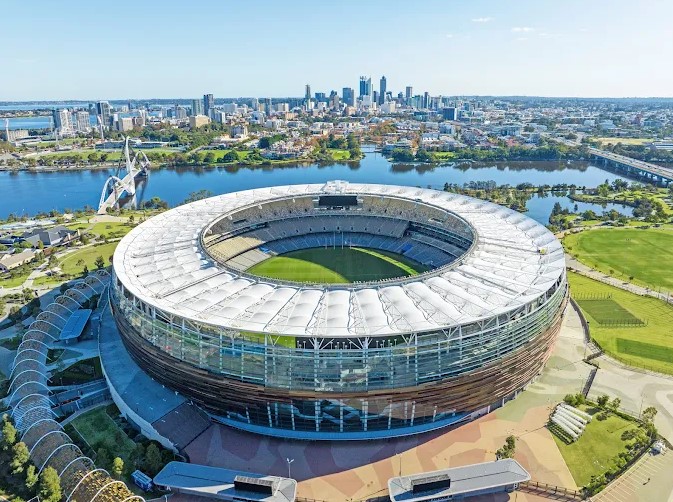Optus Stadium, located in Burswood, Perth, Western Australia, is one of the premier sporting venues in the southern hemisphere. Opened in January 2018, it has rapidly gained prominence for hosting Australian rules football, cricket, concerts, and other major events. Among the various technical aspects of a stadium, the boundary length—especially in the context of cricket and Australian rules football (AFL)—is a crucial yet often overlooked metric. This article dives deep into what the boundary length means, how it compares to other stadiums, and why it matters in professional sport.
Table of Contents
What is Boundary Length?
In the context of stadiums used for cricket and AFL, “boundary length” typically refers to the distance from the center of the pitch to the boundary rope or fence. Unlike rectangular stadiums for soccer or rugby, oval stadiums like Optus are uniquely measured because their playing areas are not uniform.
Types of Boundary Measurements:
| Type of Boundary | Description |
|---|---|
| Straight Boundary | Distance from the pitch directly down the ground (behind the bowler/batsman). |
| Square Boundary | Distance to the boundary square of the wicket (towards cover/midwicket). |
| Maximum Boundary Length | The longest distance from the center to the edge of the playing area. |
| Minimum Boundary Length | The shortest distance from the center to the edge of the playing area. |
Boundary Dimensions at Optus Stadium
| Boundary Direction | Length (in meters) |
|---|---|
| Straight Boundaries | 80-82 m |
| Square Boundaries | 65-70 m |
| Maximum Boundary | ~84 m |
| Minimum Boundary | ~64 m |
These dimensions can slightly vary depending on the pitch used (which can be placed in different positions on the central square), and the event being held.
Comparison with Other Australian Stadiums
To understand how Optus Stadium compares, let’s look at how its boundary lengths stack up against other major Australian cricket and AFL venues.
Comparative Boundary Sizes
| Stadium | Straight (m) | Square (m) | Max Boundary (m) | Min Boundary (m) |
|---|---|---|---|---|
| Optus Stadium (Perth) | 80-82 | 65-70 | ~84 | ~64 |
| MCG (Melbourne) | 75-78 | 85-90 | ~90 | ~75 |
| SCG (Sydney) | 68-70 | 60-65 | ~75 | ~60 |
| Gabba (Brisbane) | 77-79 | 70-75 | ~80 | ~66 |
| Adelaide Oval | 75-76 | 70-80 | ~86 | ~65 |
Insights:
- Optus Stadium has relatively longer straight boundaries compared to the SCG and Gabba.
- The square boundaries are shorter than MCG but comparable to Adelaide Oval.
- Overall, it provides a balanced playing field for both batsmen and bowlers in cricket and gives AFL players wide lateral movement.
Implications for Cricket
1. Impact on Batting Strategy
The shorter square boundaries make it more feasible for batsmen to play horizontal bat shots like cuts and pulls. On the other hand, the longer straight boundaries require more power or precise timing for sixes down the ground.
2. Bowling Tactics
Fast bowlers at Optus often use the long boundaries to set up catches near the fence, especially straight down the ground. Spin bowlers benefit from the wide square of the wicket, enabling fielders to cover aggressive sweeps and slogs.
Implications for AFL
1. Player Endurance and Coverage
With its relatively wide boundary lines, Optus Stadium challenges AFL players’ stamina and positioning. Teams must use strategic kicking and hand-passing patterns to cover ground efficiently.
2. Spectator Impact
A larger playing field means fans are seated slightly farther from the action compared to more compact venues like the SCG. However, Optus Stadium’s steep seating design mitigates this and offers clear sightlines.
Stadium Design and the Role of Boundary Length
Optus Stadium was designed with versatility in mind. The stadium’s oval shape accommodates various sports, each with its own ideal boundary conditions.
Sports Played and Their Preferred Field Sizes
| Sport | Typical Field Size (L x W) | Optus Stadium Compatible? |
|---|---|---|
| Cricket | 137-150m x 130-140m | ✅ Yes |
| AFL | 135-185m x 110-155m | ✅ Yes |
| Soccer | 100-110m x 64-75m | ✅ (with adjustments) |
| Rugby (Union/League) | 100-120m x 70m | ✅ (temporary setup) |
The design ensures that sports like cricket and AFL benefit from dynamic boundary flexibility, while rectangular sports are facilitated using drop-in seating and modified sidelines.
Boundary Changes and Temporary Adjustments
- Retractable seating sections
- Temporary fencing
- Movable pitch blocks
These changes ensure that players’ safety and sport-specific requirements are not compromised.
The boundary length at Optus Stadium is a well-balanced compromise between offering expansive playing space and keeping fans close to the action. With straight boundaries around 80–82 meters and square boundaries ranging from 65–70 meters, the stadium offers a competitive environment for all sports. Compared to other major venues across Australia, it holds its own with a design tailored for flexibility, performance, and entertainment.
As Optus Stadium continues to host international cricket matches, AFL finals, and major global concerts, the importance of understanding its spatial dynamics—including boundary lengths—will only grow. This metric not only influences gameplay but also affects athlete strategy, fan experience, and venue versatility.


